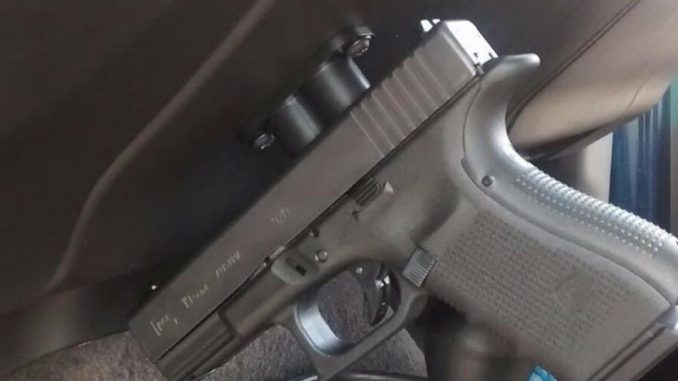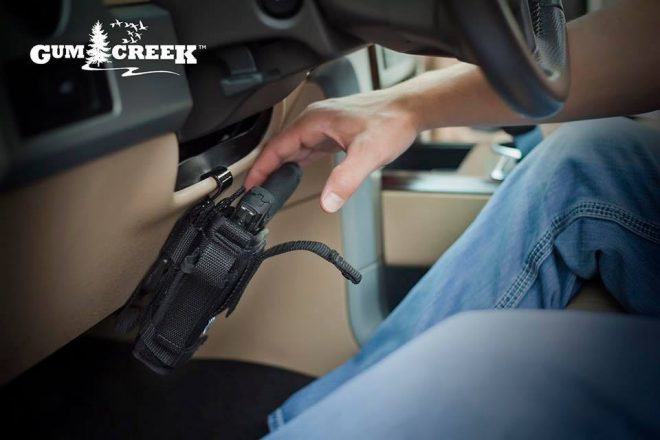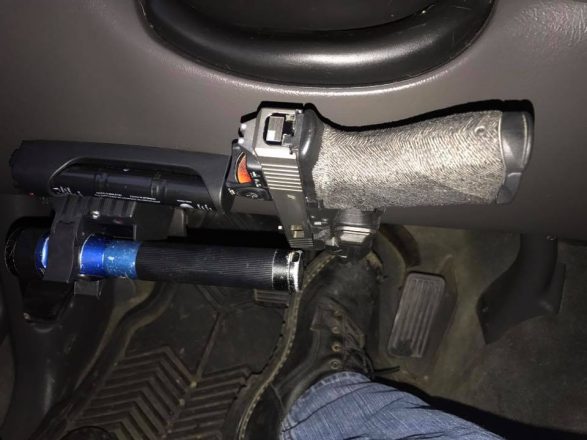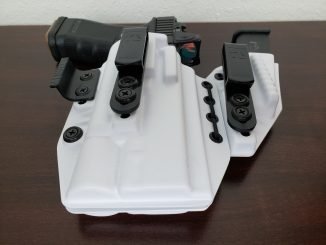
One of the most popular topics of discussion in internet gun groups is the car holster. Some mount underneath steering wheels using Velcro and nylon. Others are bolted to panels and floorboards. No matter the configuration, each design is flawed. Flawed not only in execution, but also in concept.
There are some serious issues with using your vehicle as a holster. Buckle in, we’re about to find out why.
Ballistic Projectile
Poor Holster Retention
In the event of a collision your gun will likely be ejected from its magnet or holster. The likelihood of this decreases with quality holsters, such as those with Safariland A/S/GLS retention. However, those are never what I see used for car holsters. Once ejected from the holster or magnet, the gun is now flying about the cabin. Imagine being pistol whipped in the middle of a collision. Now imagine your pistol smashing into your wife or child’s face.

This is made worse if the gun discharges during this time. Hopefully the round lands (somewhat) safely in the body of your vehicle. Maybe it leaves the cabin and hits a home or business. There’s the potential a bullet may strike you, your loved ones, or a bystander. You are morally and legally liable for anything that comes out of the muzzle of your gun. An unprotected trigger guard can lead to an accidental trigger press very easily.
Airbag Ejection
Drive any vehicle made after 1998 and you’ll have at least two airbags in the vehicle. Newer models mean more airbags; side impact curtains, roof rail bags, and more. Knee protecting airbags are becoming more and more common. Unfortunately, most people are completely unaware of their locations outside the steering wheel and passenger dash.
The three most common places I see for car holsters are underneath the steering wheel, bolted to the center console, or bolted below the instrument panel. Do you see a problem here? This puts your pistol directly in the path of your knee airbags. Coming out at roughly 100-220MPH, any objects in the way will be propelled with substantial force. Think about your pistol being smashed into your shins and knees. This not only reduces the effectiveness of your airbags, but could also result in permanent physical damage to your body.
Cutting Edge Car Holster
Hopefully your pistol and car holster stay firmly in place during a collision. Nobody wants a gun flying through the air. However, a solidly mounted gun poses problems of its’ own. Imagine getting slammed against your holstered firearm during a wreck. Greg Ellifritz, of Active Response Training shared a story a while back where this happened.
A man was T-Boned, slamming his thighs against his car holster. This severed his femoral artery and caused massive bleeding. The only reason he survived was because there were police already at the intersection who were carrying tourniquets and were familiar with how to effectively apply them.
Poor Gun Handling
Excess Administrative Gun Handling
The primary cause of negligent discharges (ND) is administrative gun handling. Loading, unloading, holstering, etc. Removing and inserting your pistol from your car holster every time you enter/exit your vehicle is giving you another opportunity to ND your gun. Factors such as poor weather, family or friends, darkness, exhaustion and more will continually increase dangers of an ND.
Poor Muzzle Control
When both driving and drawing you will most likely muzzle your legs with many car holsters. If you’re carrying in a good holster, you shouldn’t do much more than potentially graze your body should an ND happen. Get a good holster and belt combo and you’ll have no need for a car holster.

Unattended Firearms
Not having direct control of your firearm creates several issues; adding significant potential for you to leave your gun in your car when you exit–either from forgetfulness or from laziness. This leaves your gun exposed for anyone outside the vehicle to see, and potentially steal.
Even without leaving your firearm in your vehicle, in a car holster it is now exposed to those around you. Whether it’s the vehicles next to you, or law enforcement making a traffic stop. This can substantially raise tensions in situations where a concealed pistol would not.
Delayed Access
If you need to use your gun, now it is no longer on you. This will cause slower reaction times due to the farther reach required to access the gun. At worst, this could potentially prevent you from using it at all.
Imagine someone comes to carjack you. As a car holster enthusiast, they see your gun stuck to your steering wheel or center console instead of having it concealed on your person. Now you’ve lost the ability to start fighting back on your terms.
Alternatives to the Car Holster
What is my preferred alternative to a car holster? Carrying your pistol, concealed, in a solid holster. Ideally in the appendix position. With the proper holster and belt combination you can drive all day and have no issues. Your draw stroke and presentation are virtually the same as when standing. This allows for speed, safety, and consistency across multiple spectrums of training.
I typically carry a Glock 34 paired with an Aimpoint ACRO and Surefire X300u. This is carried in a Bawidamann Gotham v2 and supported by a Magpul Tejas. Using this configuration paired have taken 12+ hour road trips with zero discomfort. On the opposite end, I also carry a J-Frame in a Harry’s Holsters Icon. Small or large, appendix carry and car rides are a perfect pair.
Support My Work
If you made it this far, thanks for reading! Writing isn’t my full-time profession, and nearly everything I do comes out of my own pocket. Between ammunition, tuition, range fees and more, expenses add up fast. If you like what I have to offer, consider making a donation to my Patreon.
Every bit helps bring more work like this to you, and contributes to shortened timelines or more in-depth work on my part. You’ll also have more direct access to me, offering suggestions for future projects, looking behind the scenes, and getting early access to some content. You can find my Patreon >>HERE<<





“Drive any vehicle made after 1998 and you’ll have at least two airbags.”
Nope. My 1999 vehicle came with only one. And it’s since been deactivated.
Thanks for the constructive feedback! Glad that’s what stuck with you as a reader. This is the first in our restructuring as a car blog.